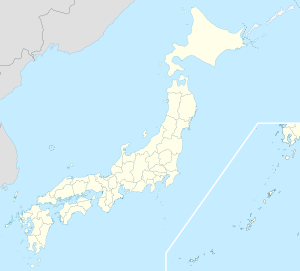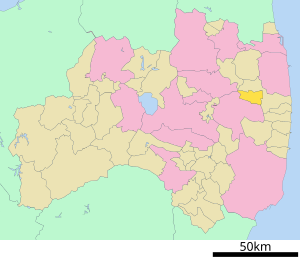Katsurao (Fukushima)
| Katsurao-mura 葛 尾村 |
||
|---|---|---|
|
|
||
| Geographical location in Japan | ||
| Region : | Tōhoku | |
| Prefecture : | Fukushima | |
| Coordinates : | 37 ° 30 ' N , 140 ° 46' E | |
| Basic data | ||
| Surface: | 84.23 km² | |
| Residents : | 420 (April 1, 2020) |
|
| Population density : | 5 inhabitants per km² | |
| Community key : | 07548-5 | |
| Symbols | ||
| Flag / coat of arms: | ||
| Tree : | Japanese red pine | |
| Flower : | azalea | |
| Bird : | Colored pheasant | |
| town hall | ||
| Address : |
Katsurao Village Hall 16 Aza Ochiai, Ōaza Ochiai Katsurao- mura, Futaba-gun Fukushima 979-1602 |
|
| Website URL: | www.katsurao.org | |
| Location of Katsuraos in Fukushima Prefecture | ||
Katsurao ( Japanese 葛 尾村 , - mura ) is a village community in Futaba County in the Japanese prefecture of Fukushima .
geography
Katsurao lies deep in the Abukuma highlands , which are characterized by forests, and are therefore largely uninhabited. Its highest point in the municipality is the Hiyama ( 日 山 ) with 1054.6 m in the northwesternmost tip, on the border with Nihonmatsu and Namie . Another neighboring municipality is Tamura in the south.
history
The community of Katsurao was established in the course of the nationwide reorganization of the community on April 1, 1889 and was located in the then Shineha ( ha 葉郡 , - gun ) district. This district was merged on April 1, 1896 with the district of Naraha ( 楢葉郡 , -gun ) to the district of Futaba ( 双 葉 郡 , -gun ), literally: "two ha ( 葉 )".
Tōhoku earthquake and nuclear disaster 2011
and the long-term evacuation zones
Orange = restricted area within a 20 km radius
Yellow = "Evacuation Prepared Area"
Pink = "Deliberate Evacuation Area"
In addition to the restricted area and “Deliberate Evacuation Area”, there are 3 categories:
Area 1 : Area ready for the evacuation order to be lifted
Area 2 = residents are prohibited from permanent residence
Area 3 = long-term unsuitable for return of residents
Damage and sacrifice
In the Tōhoku earthquake of March 11, 2011, the community of Katsurao, for which a population of 1,531 was given in the 2010 census, had relatively little damage due to its remote location. 31 residential buildings were partially, none completely, destroyed.
The Fire and Disaster Management Agency (FDMA) reported 7 deaths for Katsurao as a result of the Tōhoku disaster of 2011 up to their 145th damage report of March 13, 2012, then increased their figure in their 146th damage report of March 28, 2012 September 2012 to 16 dead and one missing person and up to the 157th damage report of 7 March 2018 to 39 dead and one missing person.
evacuation
As a countermeasure to the nuclear disaster, a restricted area was designated around the Fukushima Daiichi nuclear power plant within a radius of 20 km. However, there were also many other locations with high radiation values beyond this 20 km radius, as radioactive particles were carried away from the damaged power plant by the wind. These places included Katsurao and 10 other villages and cities, including Minamisōma , Naraha , Tomioka , Kawauchi , Ōkuma , Futaba , Namie , Iitate , Tamura and Kawamata . According to the evacuation orders of May 7, 2013, these regions were divided into four different categories according to their radioactive exposure: Areas with a radiation exposure of less than 20 mSv per year, which were treated by the government as a threshold value for permanent return Category 1. Areas of this Category 1 could be entered at their own discretion and without the use of protective equipment with the only restriction that they were not allowed to stay overnight there. These areas were ready for the evacuation order to be lifted. In areas with a radiation exposure between 20 and 50 mSv per year (category 2), residents were prohibited from permanent residence. Areas with over 50 mSv per year (category 3) were seen as unsuitable for a return of residents in the long term. A fourth evacuation area had a special status.
The Katsurao community was heavily impacted by the Fukushima earthquake-triggered nuclear disaster .
- Exclusion zone
In the east of the municipality there is a narrow strip within the 20 km exclusion zone.
- "Deliberate Evacuation Area"
The central part of Katsurao was within the 20-30 km zone for which evacuation was recommended. The municipal administration and the population therefore only moved to Aizubange and on June 15 to the nearby Miharu , where temporary accommodation was also built. On March 31 and April 1, 2017, the Japanese government revoked the evacuation orders for around 32,000 residents from the four radiation-contaminated communities of Iitate, Kawamata, Namie and Tomioka, allowing them to return to their homes. The only places that were still the subject of evacuation orders were Futaba and Ōkuma and parts of the five neighboring towns and villages Minamisōma, Iitate, Namie, Tomioka and Katsurao.
traffic
The main highway from Katsurao is National Road 399 to Iwaki or Nan'yō . There is no connection to the rail network.
education
In Katsurao there is the Katsurao Elementary School ( 葛 尾村 立 葛 尾 小学校 , Katsurao-sonritsu Katsurao shōgakkō ) and the Katsurao Middle School ( 葛 尾村 立 葛 尾 中 学校 , Katsurao-sonritsu Katsurao chūgakkō ).
Web links
Individual evidence
- ^ Reiko Hasegawa: Disaster Evacuation from Japan's 2011 Tsunami Disaster and the Fukushima Nuclear Accident . In: Studies . No. 5 , 2013, ISSN 2258-7535 , p. 1-54 . (Institut du développement durable et des relations internationales, IDDRI).
- ↑ Masaru Arakida, Mikio Ishiwatari: Evacuation . In: Federica Ranghieri, Mikio Ishiwatari (Ed.): Learning from Megadisasters - Lessons from the Great East Japan Earthquake . World Bank Publications, Washington, DC 2014, ISBN 978-1-4648-0153-2 , Chapter 11, pp. 99-108 , doi : 10.1596 / 978-1-4648-0153-2 ( work accessible online on Google Books [accessed April 3, 2018]). , License: Creative Commons Attribution CC BY 3.0 IGO.
- ↑ Mikio Ishiwatari, Satoru Mimura, Hideki Ishii, Kenji Ohse, Akira Takagi: The Recovery Process in Fukushima . In: Federica Ranghieri, Mikio Ishiwatari (Ed.): Learning from Megadisasters - Lessons from the Great East Japan Earthquake . World Bank Publications, Washington, DC 2014, ISBN 978-1-4648-0153-2 , chap. 36 , p. 331–343 , doi : 10.1596 / 978-1-4648-0153-2 ( work accessible online on Google Books [accessed April 3, 2018]). , here: p. 335, Map 36.1 "Rearrangement of evacuation zoning" "Source: Ministry of Economy, Trade and Industry.", License: Creative Commons Attribution CC BY 3.0 IGO.
- ↑ Evacuation Areas Ministry of Economy, Trade and Industry (METI), (METI Measures and Requests in response to the Great East Japan Earthquake> Assistance of Residents Affected by the Nuclear Incidents> Evacuation Areas): Restricted areas and areas to which evacuation orders have been issued (June 15, 2012) ( Memento July 9, 2018 on WebCite ) (PDF)
- ↑ 平 成 22 年 国 勢 調査 - 人口 等 基本 集 計 結果 - (岩手 県 , 宮城 県 及 び 福島 県) ( Memento from March 24, 2018 on WebCite ) (PDF, Japanese), stat.go.jp (Statistics Japan - Statistics Bureau , Ministry of Internal Affairs and communication), 2010 Census, Summary of Results for Iwate, Miyagi and Fukushima Prefectures, URL: http://www.stat.go.jp/data/kokusei/2010/index.html .
- ↑ a b 東 日本 大 震災 図 説 集 . In: mainichi.jp. Mainichi Shimbun- sha, May 20, 2011, archived from the original on June 19, 2011 ; Retrieved December 24, 2011 (Japanese, overview of reported dead, missing and evacuated).
- ↑ a b 平 成 23 年 (2011 年) 東北 地方 太平洋 沖 地震 (東 日本 大 震災) に つ い て (第 157 報) ( Memento of March 18, 2018 on WebCite ) ( PDF ( Memento of March 18, 2018 on WebCite )), 総 務省 消防 庁 (Fire and Disaster Management Agency), March 7, 2018.
- ↑ 平 成 23 年 (2011 年) 東北 地方 太平洋 沖 地震 (東 日本 大 震災) に つ い て (第 145 報) ( Memento from April 12, 2018 on WebCite ) ( PDF ( Memento from April 12, 2018 on WebCite )), 総 務 省 消防庁 (Fire and Disaster Management Agency), 145th report, March 13, 2012.
- ↑ 平 成 23 年 (2011 年) 東北 地方 太平洋 沖 地震 (東 日本 大 震災) に つ い て (第 146 報) ( Memento from April 12, 2018 on WebCite ) ( PDF ( Memento from April 12, 2018 on WebCite )), 総 務 省 消防庁 (Fire and Disaster Management Agency), 146th report, September 28, 2012.
- ↑ Dinil Pushpalal, Zhang Yan, Tran Thi Diem Thi, Yuri Scherbak, Michiko Kohama: Tears of Namie: An Appraisal of Human Security in the Township of Namie . In: Dinil Pushpalal, Jakob Rhyner, Vilma Hossini (eds.): The Great Eastern Japan Earthquake 11 March 2011: Lessons Learned And Research Questions - Conference Proceedings (11 March 2013, UN Campus, Bonn) . 2013, ISBN 978-3-944535-20-3 , ISSN 2075-0498 , pp. 80-87 .
- ↑ a b 福島 ・ 双 葉 町 役 場 ご と さ い た ま 市 へ… 1500 人 が 集 団 避難 . In: Sponichi Annex. March 19, 2011, archived from the original on March 23, 2011 ; Retrieved August 10, 2016 (Japanese).
- ↑ 葛 尾村 の 皆 さ ま へ ひ ろ が る 和 . (PDF) Katsurao, June 16, 2011, p. 1 , accessed August 10, 2016 .
- ↑ 義 援 金 及 び 支援 物資 の 御 礼 (葛 尾村) . Katsurao, August 5, 2011; archived from the original on March 9, 2013 ; Retrieved August 10, 2016 (Japanese).
- ↑ Even as Evacuation Orders are Lifted, Recovery Remains Distant Prospect for Many Fukushima Residents ( Memento July 14, 2018 on WebCite ) , nippon.com, May 24, 2017, by Suzuki Hiroshi.




